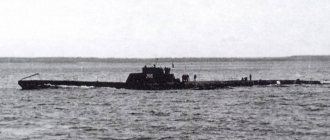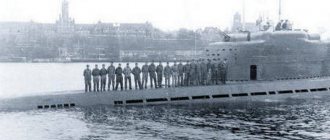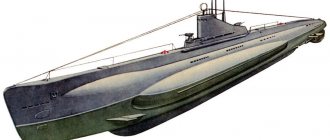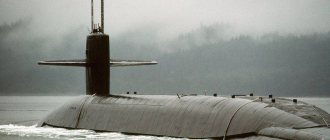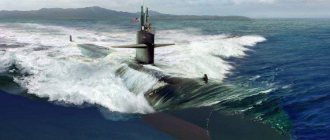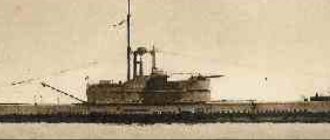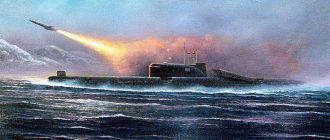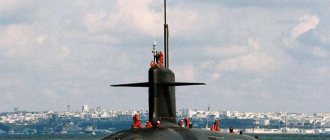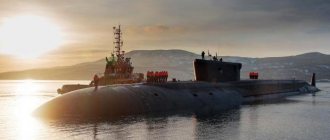Submarines of the "L" type (II, XI, XIII and XIII-bis series)
Large submarines of the “L” type (II, XI, XIII and XIII-bis series) – 24+1 units
II series: L-1 (formerly “Leninets” , 6.9.1929/28.2.1931/22.10.1933 – excluded 7.7.1945) L-2 (formerly “Stalinets” , 6.9.1929/21.5.1931/24.10. 1933 - died 14.11.1941) L-3 (formerly “Frunzevets” , 6.9.1929/28.8.1931/5.11.1933 - expelled 15.2.1971) L-4 (formerly “Garibaldiets” , 15.3.1930/31.8. 1931/ 8.10.1933 – excluded 17.2.1956) L-5 (formerly “Chartist” , 15.3.1930/5.6.1932/30.10.1933 – excluded 29.12.1955) L-6 (formerly “Carbonary” , 15.3. 1930/3.11.1932/9.5.1933 – died in April 1944)
XI series: L-7 (formerly “Voroshilovets” , 10.4.1934/15.5.1935/10.12.1936 – excluded 3.4.1958) L-8 (formerly “Dzerzhinets” , 10.4.1934/10.9.1935/29.12. 1936 – excluded 20.2.1952) L-9 (formerly “Kirovets” , 1.6.1934/25.8.1935/ 29.12.1936 – excluded 20.2.1959) L-10 (formerly “Menzhinets” , 10.6.1934/18.12. 1936/17.12.1937 – excluded 20.2.1959) L-11 (10.6.1934/4.12.1936/6.11.1938 – excluded 20.2.1959) L-12 (10.6.1934/7.11.1936/ 9.12.1938 – excluded 20.2 .1959)
XIII series: L-13 (25.4.1935/2.8.1936/2.10.1938 – excluded 17.3.1958) L-14 (25.4.1935/21.12.1936/10.10.1938 – excluded 20.2.1959) L-15 (5.11 .1935/26.12.1936/ 6.11.1938 – expelled 20.6.1956) L-16 (5.11.1935/ 9.7.1937/9.12.1938 – died 11.10.1942) L-17 (25.1.1936/5.11.1937/5.6 .1939 – excluded 4/18/1958) L-18 (12/30/1935/5/12/1938/9/24/1939 – excluded 4/18/1958) L-19 (12/26/1935/5/25/1938/11/4/1939 – died in August 1945)
XIII-38 series: L-20 (10.6.1938/14.4.1940/4.9.1942 – sank 10.10.1957) L-21 (10.6.1938/14.7.1940/7.8.1943 – excluded 29.12.1955) L-22 (4.12.1938/23.9.1939/28.8.1942 – expelled 21.5.1959) L-23 (17.10.1938/29.4.1940/31.10.1941 – died in January 1944) L-24 (20.10.1938/17.12.1940 /29.4.1942 – died in December 1942)
II series: surface – 1051 t; underwater – 1327 tons; 78x7x3.96 m; 2 diesel/2 ED, 2200/1300 hp; 13.75/8 knots; 102 tons of diesel fuel; 6000 (10)/135 (2.5) miles. Ek. 54 people 1 – 100 mm/51, 1 – 45 mm/46, 6 – 533 mm TA (6 NTA, 12 torpedoes), 20 min
XI series: surface – 1040 tons; underwater – 1340 tons; 79.9x7x3.96 m; 2 diesel/2 ED, 2200/1300 hp; 14.5/8.5 knots; 7500 (10)/135 (2.5) miles. Ek. 55 people 1 – 100 mm/51, 1 – 45 mm/46, 6 – 533 mm TA (6 NTA, 16 torpedoes), 20 min
XIII series: surface – 1120 tons; underwater – 1425 tons; 85.3x7x4.04 m; 2 diesel/2 ED, 2200/1300 hp; 15/9 knots; 143 tons of diesel fuel; 10,000 (10)/150 (2.5) miles. Ek. 56 people 1 – 100 mm/51, 1 – 45 mm/46, 8 – 533 mm TA (6 NTA, 2 KTA, 18 torpedoes), 18 min
XIII-38 series: surface – 1108 tons; underwater – 1400 t; 83.3x7x4.05 m; 2 diesel/2 ED, 4000/1300 hp; 18/9 knots; 10,000 (10)/150 (2.5) miles. Ek. 56 people 1 – 100 mm/51, 1 – 45 mm/46, 8 – 533 mm TA (6 NTA, 2 KTA, 18 torpedoes), 20 min
Boats of the “combined” type, retaining powerful torpedo weapons with the ability to lay mine banks. The design uses the experience of building submarines of the “D” type, series I, as well as solutions borrowed from the raised brit. Submarine “L-55”. One and a half hulls. The mines were stored in two horizontal strong pipes, discharged in the aft part. II series of 6 units. (three each for the Red Banner Baltic Fleet and the Black Sea Fleet) built in 1929-1933. Initially, the submarines had names, which were replaced in 1934 by alphanumeric designations. In 1934, the construction of 6 boats of the XI series began for the Pacific Fleet (entered into service in 1936-1938), a number of changes were made to the design. These submarines were laid down at factories in the European part of the USSR, after which they were transported disassembled for completion to the Far East. Based on the experience of their construction, the design of the XIII series submarines (entered into service in 1938-1939) was simplified for ease of transportation and speeding up outfitting work. In addition, a new hull was introduced on the XIII series, developed on the basis of the drawing of the IX series submarine (the diameter of the durable hull was reduced from 4.85 to 4.6 m), and 2 TTs were installed in the stern outside the durable hull, which resulted in a reduction in the number of mines with 20 to 18. The XIII-38 series differed from the previous one in a new type of diesel engine and a number of other details, the number of mines was again increased to 20, but of the six submarines laid down, not one managed to enter service by the beginning of the war. The working immersion depth for series II and XI was 75 m, the maximum depth was 90 m; for subsequent ones it was increased to 80 and 100 m, respectively. L-1 - L-3 and L-21 were part of the Red Banner Baltic Fleet during the war, L-4 - L-6, L-23, L-24 were part of the Black Sea Fleet, L-20 and L-22 were part of the Northern Fleet , the rest were included in the Pacific Fleet, but in 1942-1943. L-15 crossed the Pacific and Atlantic oceans to the Northern Fleet, and L-16 died during the transition.
L-2 died on November 14, 1941 in mines near the island. Keri. L-6 went missing between 11 and 21 April 1944 in the north-west. parts of the Black Sea; possibly killed by a mine, sunk 16/04/1944 by Herm. hunter Uj-115 or 18.4.1944 German. hunter Uj-104 and Romanians. CL “Sublocotenent Ghikulescu”. L-16 was sunk on 10/11/1942 by the Japanese submarine I-25 300 miles north-west. San Francisco. L-23 went missing between January 15 and January 29, 1944 in the Tarkhankut area - probably died in a mine. L-24 died between 12/12/31/1942 on a mine in the Kaliakra area. L-19 went missing on August 23-24, 1945 during a military campaign near the north-west. coast of the island Hokkaido - probably died in a mine. The same type L-25 XIII 38 series (building No. 198, launched 26.2.1941) was not completed; 12/20/1944 sank in a storm during an inter-base transition.
Feats in peacetime and war
"Pikes" became the most numerous pre-war submarines of the Soviet navy. It is not surprising that these particular boats turned into a kind of “floating desks” for the command and rank and file of Soviet submariners. In accordance with the pre-war doctrine, the Navy of the Soviet Union was supposed to be mainly a coastal force intended to fight the enemy primarily in its own territorial waters. A big role in this was given to submarines, which required not only building them at incredible speed, but also training their crews at the same speed.
That is why almost all the famous pre-war records related to autonomous navigation were achieved by the Shchuka. The first 40-day voyage in January-February 1936 was made by the Far Eastern Shch-117. Then there were the voyages of Shch-122 (lasting 52 days), Shch-123 (75 days), and Shch-113 achieved an absolutely incredible result, spending 102 days in autonomous navigation - from September 14 to December 25, 1936. In 1940, the submarine Shch-423 became the first submarine in the world to navigate the Northern Sea Route: on August 5, the boat set out from Polyarny, and on October 17, it arrived in Vladivostok, having covered 7,227 nautical miles, including 682 miles in ice .
All these experiments and records were very useful to Soviet sailors during the Great Patriotic War. Numerous "Pikes", quite well armed and capable of long voyages, became the main striking force of the submarine fleet of the Soviet Union. They account for a third of the total tonnage of the enemy fleet destroyed by Soviet submariners: according to various sources, from 79,855 to 233,488 gross register tons. At the same time, five boats of the Baltic Fleet, three of the Northern and two of the Black Sea were awarded the Order of the Red Banner, two Baltic, two of the Black Sea and one of the North Sea became Guards, and the Shch-402 submarine of the Northern Fleet became a Guards Red Banner ship.
For these successes, the submariners who fought on the Pike had to pay a considerable price. Three of the four submarines of this type that fought did not return to their native harbors, sank to the bottom forever. And the “Pikes”, which managed to survive the formidable war years, continued to serve in the navy until the end of the 1950s. Of course, most of them served out their term in the role not of combat submarines, but of floating charging or training stations. But there were also those that stood guard over the country’s maritime borders until the very end, for example, the Pacific Shch-137, which entered service in 1941 and left service only in 1957.
Submarine artillery weapons
In connection with the adoption of the 100mm Minizini gun, the Bolshevik plant began production of a specialized non-universal 100mm gun for submarines based on it in 1936. The 100-mm gun BNM-100 (Bolshevik, non-universal, Minizini) was installed on underwater minelayers and large submarines. Gradually, during major overhauls, submarines produced before 1936 (Dekabrist and Leninets II series, armed with a 102-mm/45 B-2 cannon) also received it. In connection with the removal of the 45-mm anti-aircraft gun from service in 1934 21 -K, medium and small submarines of the first releases were produced without artillery installations, although with platforms for their subsequent installation. It was planned to equip them with large-caliber machine guns, but the creation of machine guns was delayed until 1939. In 1940, the urgent need for DShKs on the part of ground forces and surface ships prevented equipping small and medium-sized submarines with machine guns. In addition, they were supposed to operate primarily in the coverage area of coastal aviation. In mid-1940, on the initiative of the Naval Artillery Directorate, weapons designer Grabin completed the creation of working drawings for the 76-mm F-35 naval gun based on the F-22 divisional gun. At the beginning of 1941, after completion of factory tests, a prototype of the 76-mm F-35 artillery mount was installed on the Shch-204 submarine (commander - Lieutenant Commander I. M. Gritsenko). After completing ship tests, the F-35 was recommended for adoption. However, there was no order for serial production from the Red Army Navy. Firstly, in connection with the unexpected surrender of France in the summer of 1940, the approach of a big war was quite obvious, and the construction of new workshops and the expansion of F-35 production contradicted the general direction of the military-industrial complex in 1941: everything for the ground forces and aviation, at least for fleet. Secondly, by 1940, the concept of abandoning artillery weapons for small and medium-sized submarines had gained momentum among practicing submariners. The submariners took into account that, given the slow speed of small and medium-sized boats, their tactical tasks would be more likely to organize underwater ambushes and torpedo attacks than to engage in an artillery duel with surface vessels. Arming small and medium-sized boats with artillery installations would require increasing their crew, which was already serving in cramped conditions, and would also entail a decrease in underwater speed. Thus, small and medium submarines met June 1941 without artillery weapons. Most of the large submarines and minelayers were, in addition to the 100 mm gun, by June 1941 were additionally armed with DShK machine guns.
Submarine torpedo weapons
The torpedo tubes of submarines of the first half of the thirties were air driven: the torpedo was fired with compressed air. Torpedo tubes operating in this way unmasked the boat due to the formation of an air bubble with each torpedo shot. During the interwar period, bubble-free torpedo firing systems began to be developed. The first in this direction were European countries - Holland, Germany, Great Britain. The principle of operation of the European bubble-free firing system was that after the torpedo acquires the required speed of movement in the apparatus (after passing two-thirds of the length of the pipe), the exhaust valve automatically opens and air is bypassed from the torpedo tube into the durable body. German Type VII submarines, as well as Soviet submarines after 1937, used a pneumatic piston rather than directly compressed air to push out the torpedo, which significantly simplified the design of bubble-free torpedo firing. The compressed air pushing the piston was released not into the water, but into the torpedo compartment.
